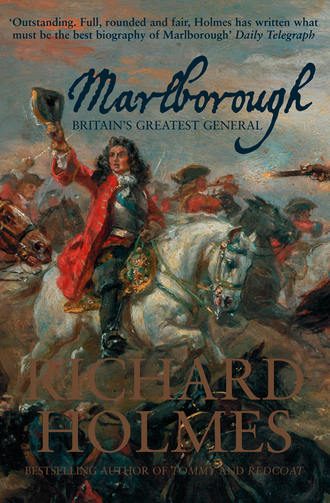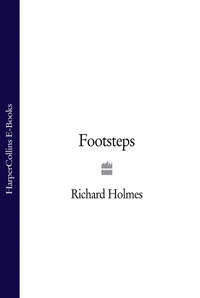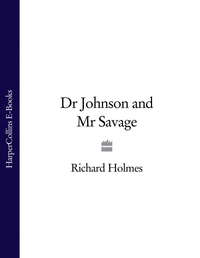
Полная версия
Marlborough: Britain’s Greatest General
Sarah remembered that John had told her that the duke had given him his sword to prevent the boat from being stormed by panic-stricken men, and Sir John Berry agreed that Churchill had kept the boat free from intruders.
James himself told William of Orange that ‘considering the little time the ship was above water after she struck first’, the loss of life might reasonably have been greater, and if he had known that Ayres had survived the wreck he would ‘have been hanged up immediately, according to the custom of the sea’. Some other accounts emphasise that there was a delay between first impact and sinking, and if this is so one might conclude that James’s hesitation prevented more passengers from getting aboard the lifeboat, and his insistence that the ship might yet be saved probably delayed the issuing of an early order to abandon her. However, we cannot be certain how long Gloucester remained on the sandbank before slipping to her doom. Winston S. Churchill, with his own reasons for emphasising the delay, suggests that it was ‘about an hour’, but Sir John Berry, an eyewitness, though with a reputation at risk, recalled how ‘for a moment or two she beat upon the sands; then a terrible blow knocked off her rudder and tore her side open’.29
The loss of life was certainly not all James’s fault: more seamen and passengers might have survived had they been able to swim. The tubby Sir John stayed on his quarterdeck until the vessel sank, and then swam to the Happy Return, which had anchored just short of the sands. The duke’s equerry Edward Griffin saved himself by clinging to a chicken-coop, and the Marquis of Montrose was hauled from the sea into James’s boat. Among those lost were Lords Roxborough and O’Brien and a number of gentlemen, including Laurence Hyde’s brother James, the ship’s lieutenant, and it was this loss of genteel life (almost like a microcosm of the Titanic) that struck contemporaries. Pepys was ‘sensible of God’s infinite mercy’, for he had no doubt that he would have drowned had he been aboard Gloucester: ‘For many will … be found lost as well or better qualified to save themselves by swimming than I might have been.’30 James ordered donations to the widows and orphans of the drowned seamen, but there can be no doubt that the episode had done little to enhance his status in the eyes of many of those close to him.
The duke and his party set off for England aboard the aptly named Happy Return on 15 May. The journey was an unpleasant one for Mary of Modena, so heavily pregnant that she had to be hoisted aboard in a chair-lift. The homeward voyage took twelve days, and it may be that its discomfort contributed to the premature birth of Charlotte Mary, who lived only till October. Just over a month after her death, on 21 December 1682, John was rewarded for his services with the barony of Churchill of Aynmouth in the peerage of Scotland. This made him a Member of the Edinburgh Parliament, which then sat in the great hall known as the Parliament House off the High Street. There the three estates, nobles, barons and burgesses, debated and voted together as a single chamber.31 In view of Churchill’s work over the past three years the grant of a Scots peerage was not as puzzling as it might seem. Although it was not of as much practical value as a seat in the English House of Lords, it was certainly more dignified than an Irish peerage, proverbially the cheapest coinage available to reward supporters of the government.
Domestic Bliss, Public Prosperity
Lord and Lady Churchill settled in Holywell House, Sarah’s family home near St Albans. John’s income – now increased by his appointment to the virtual sinecure of command of the Third Troop of Life Guards on £1 a day – had been sufficient to enable him to buy Frances Tyrconnell’s share of the Jennings family home in 1681, and three years later the Churchills demolished the old house and built a new one, with elegant gardens and fish ponds. It was their favourite home. Sarah said in 1714 that however ordinary it might be, she would not part with it for any she had seen on her travels, and on St George’s Day 1703 John wrote whimsically to her that: ‘This being the season I hear the nightingales as I lie in my bed I have wished them with all my heart with you, knowing how you love them.’32
Churchill resumed court life with enthusiasm. Charles had long forgiven him for his affair with Barbara Castlemaine, and he was now one of the king’s regular tennis partners. He shared this honour with Louis de Duras, his comrade in arms from the Alsace campaign, who had now inherited his father-in-law’s peerage and become Earl of Feversham, and Sidney Godolphin: they were ‘all so excellent players that if one beat the other ’tis alternatively’. Godolphin, born on the family estate at Helston in Cornwall in 1645, was a short, ungainly and rather taciturn man. His poet grandfather had died fighting for the king in a West Country skirmish, and his father Francis – who sired no fewer than sixteen children – had raised a regiment of royalist foot.33 Like Sir Winston Churchill, Sir Francis Godolphin was rewarded after the Restoration, and in 1662 young Sidney became a royal page. He had married Margaret Blagge in 1675, though he lost her, all too early, to puerperal fever. John Evelyn wrote that ‘She was the best wife, the best friend, the best mistress, that husband ever had,’ and he saw how Sidney, ‘struck with unspeakable affliction, fell down as dead’.34 Their surviving child, Francis, was to marry the Marlboroughs’ daughter Henrietta in 1698.
Godolphin became MP for the family borough of Helston in 1668, and cut his teeth on a variety of diplomatic missions over the next decade. He was at once unobtrusive and indispensable: Charles II quipped that he was ‘never in the way and never out of the way’. In 1679 he joined Sunderland and Laurence Hyde in the short-lived governing group unkindly known as ‘the chits’ for the youth and inexperience of its members, but he managed to retain royal favour during the Exclusion crisis, possibly because he was ill at several crucial moments. Hyde, holding the important post of lord treasurer, became Earl of Rochester in 1682, and two years later he was, as Halifax put it, ‘kicked upstairs’ to the less demanding job of lord president of the council. Godolphin, raised to the peerage as Baron Godolphin of Rialton, replaced him. With the accession of James II in 1685 he became lord chamberlain to the queen, and when she attended chapel was ‘accustomed … to give her his arm as far as the door’. He sided with James in 1688 but soon made his peace with William and Mary.
Godolphin was to become Churchill’s principal political ally, and the Marlborough – Godolphin correspondence, so painstakingly transcribed by Henry L. Snyder, remains ‘one of the most famous and important in English history’.35 Snyder’s work corrects most of the errors in dating and transcription which, initially made by Archdeacon Coxe, were sometimes perpetuated by Winston S. Churchill. The letters illuminate several non-martial aspects of Churchill’s career, not least in his dealings with the Dutch, and reveal what Snyder calls his ‘essential timidity and the extreme care he took to obtain authority for his every action’.36 This correspondence did not begin in earnest till 1701, when both Churchill and Godolphin were in positions of substantial influence, but it is surely right to see in the correspondence of prime minister and commander-in-chief a reflection of a much earlier friendship.37
A measure of Churchill’s favour was his appointment, on 19 November 1683, as colonel of a regiment which had begun its life as the Tangier Horse and was now known as the King’s Own Regiment of Dragoons. The post, held in plurality with command of the Life Guards troop and the colonelcy of foot, was worth another fifteen shillings a day in pay and allowances. Dragoons derived their name from the fact that they originally carried a ‘fire and cock’ musket – a weapon, like its users, called dragon in French – which was a primitive form of flintlock, rather than the matchlock musket of Civil War infantry. They were mounted, though traditionally on cheaper steeds than cavalry proper: the New Model’s cavalry horses cost £8–£10 apiece, but half that sum would buy a dragoon nag.
Dragoons originally fought on foot, with their horses simply providing them with tactical mobility or, as their enemies alleged, enabling them ‘to be fitter to rob and to pillage’.38 They sometimes fought on horseback even during the Civil War, and after it they gradually ascended to be cavalry proper, although the whole process was to take them at least a century. The Military Dictionary of 1702 described them as:
Musketeers mounted, who sometimes serve a-foot, and sometimes a-horseback, being always ready upon anything that requires expedition, as being able to keep pace with the horse, and do the service of foot. In battle, or upon attacks, they are commonly the Enfants Perdus, or Forlorn [Hope], being the first that fall on. In the field they commonly encamp either at the head of the army, or on the wings, to cover the others, and be the first at their arms.39
Churchill was an infantry officer, and his appointment as a colonel of dragoons was seen by his enemies almost as a breach of natural law. There was some whinnying:
Let’s cut our meat with spoons!
The sense is as good
As that Churchill should
Be put to command the Dragoons. 40
He made a good start with his regiment, however, issuing the men with new red coats faced with blue, and keeping the annual cost of each troop down to £2,200, evidence of his ‘careful administration’. Churchill’s lieutenant colonel was Lord Cornbury, grandson of Edward Hyde, Earl of Clarendon, Charles’s first chancellor, and so nephew to the Duke of York’s deceased wife Anne Hyde. It was to prove a portentous connection.
There were limits to royal benevolence. When somebody suggested that Churchill might make a good ministerial colleague for Sunderland, Charles replied bluntly that ‘he was resolved not to have two idle Secretaries of State’. Churchill was certainly much preoccupied with rebuilding Holywell House, and with his growing family. Another daughter, Anne, was born in 1684, John (a son at last) followed in 1686, Elizabeth in 1687, Mary in 1689 and Charles, who lived for only two years, in 1690. There is no evidence, during the early 1680s, of a man eaten up by ambition. He had his peerage and a colonelcy, stood high in royal favour, and perhaps Charles’s suggestion of temporary indolence is not unfair, for he was still a young man but not now in much of a hurry. Indeed, if anyone in the family was making the running at this period it was not John, but Sarah.
Sarah Jennings had first met Lady Anne, youngest daughter of James, Duke of York and Anne Hyde, at Whitehall when Sarah was ten and Anne only six, and they appeared together in a court production of the masque Calisto in December 1674. They had seen a good deal of one another in Scotland, and in 1680 Sarah was on hand when Anne was involved in a controversial relationship with John Sheffield, Lord Mulgrave, a great favourite of the king’s but, at thirty-five, almost twice her age. Although London gossips suggested that Mulgrave had seduced her ‘so far as to spoil her marrying to anyone else’, Mulgrave had probably done no more than write letters ‘intimating too near an address to her’. He was exiled to Tangier, but went on to hold high office under James II, William III, who made him Marquess of Normanby, and Queen Anne herself, who created him Duke of Buckingham.41
The Mulgrave affair both accelerated efforts to get Anne suitably married, and, as the historian Edward Gregg is right to suggest, ‘underlined – and perhaps contributed to’ a growing divergence between Anne and her elder sister Mary, whose hints of displeasure at Anne risking her reputation were not welcomed by someone who did not believe that she had done anything at all to contribute to the scandal. Bruised by her sister’s priggishness, and thrust on inexorably towards an arranged marriage, Anne became increasingly attracted to the beautiful, intelligent and witty Sarah. Their friendship was to be so closely interwoven with John Churchill’s own rise that we cannot hope to tease the strands apart. Nor can we be certain of the precise nature of the relationship, because Sarah, who wrote most about it, did so mainly after the burning affection of its early years had frozen into mutual contempt.
We have two main difficulties. The first is that it is never easy for men to grasp the depth and intensity of the love that can exist between women. Even the most heterosexual of men usually know that they have bonds of affection with other men that are indeed ‘passing the love of women’, even if they are not always comfortable in talking about them. Yet it is hard for them to acknowledge that women can have relationships which are as profound, partly because of men’s fear that women’s affection is in some way finite, and that the emotion which binds them to other women must necessarily limit that available for commitment to men.
Our second problem is that the relationship between Anne and Sarah has now become part of the battlefield of sexual politics. Some lesbian authors have suggested that the relationship was indeed lesbian, and that it is only the gender-centric perversity of the historical establishment that has prevented a proper acknowledgement of the fact that European courts at this time were full of girls and women in loving physical relationships, and historians who deny it are simply revealing their inherent homophobia.
It is important to understand that correspondence may mislead us. In a letter whose sheer nobility mists one’s eyes even today, Margaret Godolphin told Jael Boscawen, her sister-in-law, ‘My dear, believe me, that of all earthly things you were and are most dear to me.’ She evidently did not mean that she loved Jael more than she loved Sidney, for ‘Nobody ever had a better or half so good a husband.’ Yet her affection for Jael went beyond this happiest of marriages. So: ‘Not knowing how God Almighty may deal with me … as in case I be to leave the world, no earthly thing may take up my thoughts,’ it was to Jael she wrote just before her confinement, bidding farewell to mortality and putting her affairs in order.42 When Anne’s sister Mary wrote breathlessly, ‘What can I say more to persuade you that I love you with more zeal than any lover and I love you with a love that was never known by man I have for you an excess of friendship more of love than woman can for woman and more love ever than the constant lover had for his mistress …’ she was in fact writing to Frances Apsley, daughter of the Duke of York’s treasurer.43 Both women enjoyed happy marriages. Just before her own marriage Anne also wrote to Frances, in a letter veiled in classical allegory: ‘Your Ziphares [Anne] changes his condition yet nothing shall ever alter him from being the same to his dear Semandra [Frances] as he ever was.’
Women often wrote passionately to one another, even if there was nothing physical in their relationship. One of Sarah’s biographers, Ophelia Field, declares that ‘it can never be certain what unlabelled feelings – feelings which Sarah would manipulate skilfully in later life – existed between the two. For now, it is enough to emphasise that Sarah and Anne were not entirely innocent of what their words might mean if history happened to eavesdrop.’44 When we do listen at history’s keyholes, let us do so as honestly as we can, neither making the easy assumptions that such whispers might imply today, nor putting our characters on a political stage which is our creation, not theirs.
There can be no doubting Anne’s need for female affection. Sarah became her lady of the bedchamber in 1683 on Anne’s marriage to Prince George of Denmark, replacing Mary Cornwallis, of whom Charles II said that ‘No man ever loved his mistress as his niece Anne did Mrs Cornwallis.’45 When Sarah lost her hold on Anne’s affection she did not simply alienate Anne by her filthy temper and overbearing behaviour, but because she was insidiously outmanoeuvred by Abigail Masham.
Sarah’s own account of her friendship with Anne is best encapsulated in An Account of the Conduct of the Dowager Duchess of Marlborough from her first coming to court …, although so much of what she wrote in later life, on her own account or in collaboration with associates like Bishop Burnet, in some way reflects the catastrophic end of that relationship. She claimed that she wrote the book knowing that ‘I am coming near my end, and very soon there will be nothing of me but a name’, and wanted to comment on ‘the successful artifice of Mr Harley and Mrs Masham in taking advantage of the Queen’s passion for what she called the church to undermine me in her affections’.46
Sarah made much of her early friendship with Anne: ‘We used to play together when she was a child, and even then she expressed a particular fondness for me.’ This gave her an important advantage, accentuated by the fact that the manners of the Countess of Clarendon, first lady of the bedchamber, ‘could not possibly recommend her to so young a mistress: for she looked like a mad-woman, and talked like a scholar’.47 Sarah maintained that flattery was ‘falsehood to my trust, and ingratitude to my greatest friend; and that I did not deserve so much favour, if I could not venture the loss of it by speaking the truth’. Kings and princes, she believed, generally thought that the dignity of their position would be eroded by friendship with an inferior. ‘The Princess had a different taste,’ she wrote. ‘A friend was what she most coveted: and for the sake of friendship (a relation which she did not disdain to have with me) she was fond even of that equality which she thought belonged to it.’ They eventually decided to address one another by assumed names.
Morley and Freeman were the names her fancy hit upon; and she left me to choose by which of these I would be called. My frank, open temperament naturally led me to pitch upon Freeman, and the Princess took the other; and from time to time Mrs Morley and Mrs Freeman began to converse as equals, made so by affection and friendship.48
There were other nicknames too: William of Orange, whom neither much liked, was ‘Mr Caliban’.
An unpublished account of this period written in the third person by Sarah much later tells us how:
she now began to employ all her wit and all her vivacity and almost all her time to divert, entertain and serve the Princess; and to fix that favour, which one might now easily observe to be increasing more towards her each day. This favour quickly became a passion; and a passion which possessed the heart of the Princess too much to be hid. They were shut up together for many hours daily. Every moment of absence was counted a sort of tedious, lifeless state. To see the Duchess was a constant joy; and to part with her for never so short a time, a constant uneasiness; as the Princess’s own frequent expressions were. This worked even to the jealousy of a lover. She used to say that she desired to possess her wholly: and could hardly bear that she could escape, from this confinement, into other company.49
In another account, this time part of Sarah’s published campaign to defend her reputation, she maintains that all Anne’s friendships ‘were flames of extravagant passion, ending in indifference or aversion’. She ‘seemed to inherit a good deal of her father’s moroseness’, thought Sarah, ‘which naturally produced in her the same sort of stubborn positiveness in many cases, both ordinary and extraordinary, as well as the same sort of bigotry in religion’.50
In July 1683 the eighteen-year-old Anne was married to Prince George of Denmark. John Evelyn thought that ‘He had the Danish countenance, blonde, of few words, spoke French but ill, seemed somewhat heavy, but reported to be valiant, and indeed he had bravely rescued and brought off his brother the King of Denmark in a battle against the Swedes.’51 The arrangement suited Louis XIV, who hoped to see the two naval powers united against the Dutch, as well as James, who was trying to limit the influence of his other son-in-law, William of Orange. Negotiations were handled by Anne’s uncle Laurence, now Earl of Rochester, and secretary of state Sunderland. They drove a hard bargain: James gave the couple £40,000 in capital and £5,000 a year. Anything else had to come from Prince George’s personal estates, and he was expected to reside in England. The Danish ambassador suggested to his French colleague that it would suit them all if Anne and George could be given precedence in the succession over William and Mary, but the Frenchman replied that hereditary right could not be brushed aside like this.
Charles II deftly summed up George, saying: ‘I have tried him drunk and I have tried him sober and there is nothing in him.’ He was indolent and good-natured, devoutly Protestant (a Lutheran, and so, in English terms, a dissenter rather than an Anglican, which made him an ‘occasional conformist’ to the services of the established Church), wholly free from scandal, and as wholly devoted to Anne, who bore him child after stillborn child in an almost annual succession of perhaps as many as seventeen pregnancies, although Anne’s predisposition towards false pregnancies make it impossible to be sure. The best estimate is probably twelve miscarriages, one stillbirth and four children who died young. Only one of their children, William, Duke of Gloucester (1689–1700), survived early childhood. Notwithstanding Anne’s relationship with Sarah this was a happy marriage, and Anne always acknowledged that though she might be queen, George was head of the household. In 1708 she nursed him through his last illness, and his death
flung the queen into an unspeakable grief. She never left him till he was dead, but continued kissing him till the very moment the breath went out of his body, and ’twas with a very great deal of difficulty my Lady Marlborough prevailed upon her to leave him.52
Just as there is no reason to doubt Anne’s affection for her husband, so too we can see why Anne expected more emotional engagement than he was able to offer, and understand how Sarah fitted into this relationship. Ophelia Field’s suggestion that ‘the marriage contained many of the qualities of a friendship while Sarah’s relationship with Anne was developing into a fraught romance’ seems exactly right.53
It is an index of the Churchills’ position that John had been sent to Denmark to bring George to England for his wedding, and when it was decided that the prince’s prickly private secretary, Christian Siegfried von Plessen, should be sent back to Denmark, it was John who made the arrangements and Sarah’s brother-in-law Colonel Edward Griffith who replaced Plessen. Anne and her husband were given apartments known as the Cockpit in the Palace of Whitehall, across King Street from the Privy Garden, just to the west of Horse Guards. Adjacent parts of the palace were occupied by the secretaries of state, and it is no coincidence that Downing Street, so close to the Cockpit, has now assumed its importance. With King Street acting as a firebreak the Cockpit survived successive fires, and Anne remained there until ordered to quit by her sister.
A Cockpit circle was quickly scribed out. Near its centre were John and Sarah Churchill, with John’s brothers, Captain George Churchill of the Royal Navy and Lieutenant Colonel Charles Churchill (who had once served as a page to Prince George’s brother King Christian), Colonel John Berkeley, of Anne’s dragoon regiment, and his wife Barbara, daughter of Lady Villiers, who had been the princess’s governess. Sir Benjamin Bathurst, comptroller of the household, was now married to Frances Apsley. The Duke of Grafton, one of Charles’s bastards by Barbara Castlemaine, was a regular visitor, as were the Marquess of Ossory (who succeeded as Duke of Ormonde in 1688) and the Earl of Drumlanrig (Marquess of Queensberry in 1695). Robert and Anne Spencer, Earl and Countess of Sunderland, were on the outer edge of the circle. They were close to the Churchills, and Anne Churchill was to marry their eldest son Charles, but, because of Sunderland’s support for the Exclusion Bill, Anne never really trusted him.54 Sarah was promoted to first lady of the bedchamber when Lady Clarendon went off to Ireland with her husband, who had been made its lord lieutenant.









